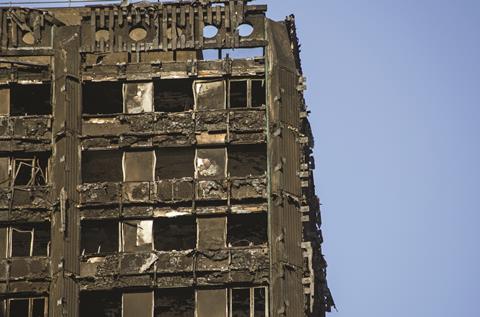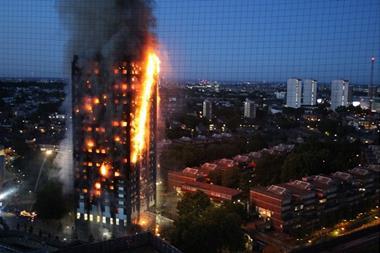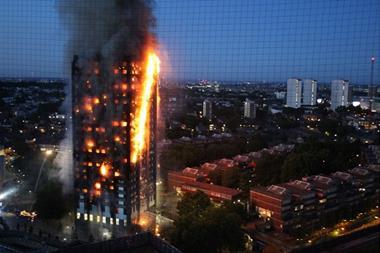London’s high-rise disaster raises disturbing questions about fire safety

When the world woke up on 14 June this year and saw images of London’s 24-storey Grenfell Tower in flames, the initial reaction was horror.
But almost as quickly, questions occurred to anyone with a responsibility for property. They asked, could such a disaster happen again? And if so, what kind of actions might prevent it?
This dreadful event will change the way fire safety is managed in the UK and how buildings are designed and maintained. Although the initial focus has been on high-rise residential buildings, concerns over combustible cladding and fire safety will also affect hospitals, hotels, cinemas, shopping centres and many other types of building.
And as far as the law is concerned, the position is clear. All building owners and operators have a statutory duty to assess the risk of fire, according to Hugh Forster, property risk practice leader at Marsh Risk Consulting.
“All organisations should review their fire risk assessments in light of Grenfell and look closely at whether their buildings share any of the relevant characteristics, including combustible cladding, residential or sleeping occupants and single exit routes,” he says.
Another requirement is that fire risk assessments are carried out by someone competent to do so. “While building owners and occupiers must take responsibility for the assessment, they should take advice where fire issues may exceed their own competence,” says Forster.
But while managers can take some comfort from the fact that the UK’s commercial estate is highly regulated – it is very rare for someone to die from fire in the workplace – this does not mean all is well. There are still some organisations that are not fully aware of their risk.
“Fires of a magnitude of Grenfell are commonplace within the commercial estate but never hit the news because they are not accompanied by life loss,” says Dr James LD Glockling, technical director of the Fire Protection Association and director of RISCAuthority.
“Traditional businesses are familiar with business continuity planning and have a much better idea than most of how good building design and material selection can improve the resilience of their business.”
Strange choices
However, Glockling believes risks are present in those organisations that are businesses but do not always behave that way, such as schools, hospitals and social care providers.
“I see some very strange choices being made in building design and materials chosen, which promote value and sustainability greatly but at the expense of resilience,” he says.
“Methods comprising combustible construction, cladding and insulation are commonplace and promotion of features such as sprinklers rare.”
One reason for this could be that the existing fire safety legislation is excessively complex, open to interpretation and needs reform.
Because of this, the Association of British Insurers has been calling on the government to review building fire-safety regulations since 2009 – and tragically, warned in May this year that combustible external cladding on high rises could cause fire to spread.
As such, managers need to go beyond the legislation to truly get across their risk.
“Compliance with building regulations should be a starting point and provide a minimum standard, with higher standards being preferred where available,” says Forster.
Glockling agrees that companies need to go beyond building regulations. “I believe there is an immense and universal misunderstanding of what building regulations seek to achieve and just how low the bar is,” he says. “I believe most people believe that there is a significant amount of property protection afforded by the regulations. But there is not.
“This misconception is very harmful in that it prevents those in a position of doing more from even looking.
“In other countries, life safety follows on from good specification of property protection. In the UK, the two are totally divorced and we know this can lead to buildings that are very weak to fire.”
To truly manage the fire risk, firms need to be asking more of their contractors when property is built.
“Building regulations and other requirements protect your workforce but not your business,” says Glocking.
“If you ask for nothing more when commissioning a building, it is most likely that the architect, designer and fire engineer will quite legitimately deliver the bare minimum at the lowest cost.
“Such buildings might well be beautiful, compliant and functionally appropriate. But they might be very weak to supporting your business when challenged by fire.”
Firms need to understand that they can specify how they would like a building to perform in the event of a fire and insist on non-combustible materials and suppression systems, such as sprinklers.
It really is up to you. “The UK supply chain can deliver all that is asked for,” says Glocking.
What are the lessons that businesses can learn from the blaze?
1. Robust, well-rehearsed business continuity and crisis management plans should be in place that consider major incidents such as Grenfell.
2. Over and above a strong plan, organisations should be thinking through the resources required to deal with crisis management. The Grenfell Tower fire highlighted that the local authority did not appear to have sufficient resources to deal with the aftermath of the incident, and did not have a plan to tap into additional resources at very short notice.
3. The fire once again brought into stark focus the challenges of supply chain risk management. The public sector in particular, but also the private sector, needs to improve the calibration of risk management in its supply chains, to avoid applying a low minimum standard to all procurement.
4. Adequate all-round risk assessment is paramount. Although fire risk assessment is a legal requirement, it is good practice to assess all the risks facing a business.




















No comments yet